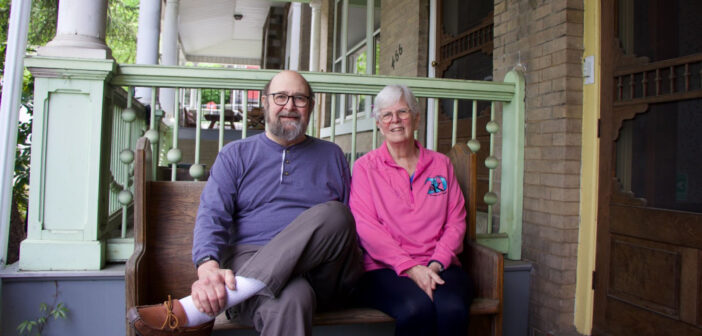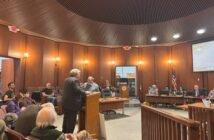South Bethlehem is changing. Visible differences include the addition of new businesses and apartments and the historical restoration of old buildings.
South Side community leaders and residents reflect on the community’s past, where it is now and what they foresee in South Bethlehem’s future. While their perspectives, hopes and goals are not unanimous, one thought is shared among them: South Bethlehem is undergoing many major changes.
South Bethlehem Residents and Housing Advocates
When Anne and Craig Evans, longtime South Bethlehem residents, set out to buy a home in 1981, they were looking for one with historical character in a place with convenient access to grocery stores, schools for their kids and activities.
Craig Evans said they ended up buying a house on Montclair Avenue because the house hadn’t been “remodeled to death.”
Over the years, the community surrounding the house has changed as Lehigh has continued to grow, increasing the number of student renters.
“We have had some great student neighbors but we have also had some that would open the front doors and throw beer bottles across the street or invite 200 of their friends over with red solo cups,” Craig Evans said.
The pair said they have called the police on dozens of parties, which ultimately led to quieter students renting the houses around them, but people still ask the couple why they haven’t moved.
“We chose to stay here for the same reasons that we chose to be here: convenience, and it is more economically feasible to do so,” Craig Evans said.
As development in South Bethlehem increases, the Evans’ said they want to make sure historical preservation and the community that has lived here for generations remains a priority. Craig Evans sits on the Historical Conservation Commission in an effort to accomplish this goal.
Anne and Craig Evans have attended city council meetings for years and continue to do so to advocate for the community that holds their hearts.
Anne Evans said she enjoys the walkability of South Bethlehem, which has allowed them to send their kids to extracurricular activities, school and friends’ houses within a short distance. However, she does not walk downtown as much anymore because it is “not the same.”
Anne Evans said she is optimistic for the future of South Bethlehem if the developments stay contained to certain areas of the community and student housing stays in city-stationed overlay zones.
She said the city needs to work on preserving the neighborhoods that have existed for generations.
“This house will be standing for another 100 years,” Anne Evans said. “I can’t say the same about Five 10 Flats.”
The Evans’ said they like the idea of a short moratorium or pause on development.
Craig Evans said if people want to keep developing South Bethlehem, they will have to wait.
“The same reasons that you want to come here are the same things that we need to protect,” Anne Evans said. “We need to stop right now and figure out how we want to protect those things and what our priorities are going to be.”
Former Mayor and Peron Development
John Callahan, former Mayor of Bethlehem, is involved in all levels of real estate investment at Peron Development and sits on the board of 10,000 Friends of Pennsylvania, a statewide smart growth project.
Smart growth, defined by Smart Growth America, is an approach to development that encourages different types of buildings, diverse housing and transportation options, and robust community engagement.
When asked about future developments, Callahan said decisions must be made solely based on fact rather than emotions that arise from anecdotal stories.
Bethlehem-based Peron Development owns several properties, including Five 10 Flats, which Callahan said are mostly geared toward young professionals and empty-nesters rather than the student population.
“Our goal is to provide a product for those young professionals who wouldn’t have otherwise considered the South Side in order to create a knowledge neighborhood,” Callahan said.
He said a knowledge neighborhood is a community where people can work, play and learn in a safe, walkable and somewhat dense environment.
He said big technology companies such as Ben Franklin and OraSure, along with ArtsQuest and events at the SteelStacks, make South Bethlehem a perfect place for a knowledge neighborhood.
“To me, that is the trick of livability,” Callahan said.
In the past five years, Peron Development has invested $70 million in building a total of 270 units between four projects.
Callahan said he is proud Peron Development has built and continues to develop vacant lots so they aren’t kicking South Side residents out of their homes and displacing them.
Callahan said wanting to slow down development in the community is a knee-jerk reaction that doesn’t make sense.
“It is important for people who are concerned about gentrification…to remember the amount of effort and investment and intentionality that it took to get here,” Callahan said. “That long-term view is missing.”
As of the 2020 census, the Lehigh Valley Planning Commission reports the Lehigh Valley has the largest shortage of middle-income housing for families making $25,000-$99,999 a year.
Callahan said by building housing for higher-income families, Peron Development and Lehigh Valley Planning Commission hope to take the pressure off of the middle-level income housing market so families who cannot afford anything more expensive can live in those properties.
Community Action Development Lehigh Valley
Anna Smith, director of Community Action Development Bethlehem located on Fourth Street, said now is the time to think about what residents want South Bethlehem to look like in 30 years.
Smith, also a longtime South Bethlehem resident, said there are many uncertain questions about the future.
She said there are plans for several new developments in the next few years, which will most likely add more than 1,000 residents to the community.
The City of Bethlehem approved more than 3,000 new buildings in 2022, most of them located in South Bethlehem.
“We need to make sure there are safeguards in place so that folks who have called our community home, who want to stay here, have invested in our neighborhoods and who come from diverse incomes backgrounds are able to,” Smith said.
Due to the complexity of development project issues, Smith said she is hesitant to say if they negatively or positively affect the community.
She said bringing new residents to live on the South Side is not a bad thing but there needs to be recognition of the people and history that already exist here.
“We want our community to be a welcoming, mixed-income community, but as an organization, as a whole community and as a city government, we need to validate the concerns of residents who have been here for generations,” Smith said.






Comment policy
Comments posted to The Brown and White website are reviewed by a moderator before being approved. Incendiary speech or harassing language, including comments targeted at individuals, may be deemed unacceptable and not published. Spam and other soliciting will also be declined.
The Brown and White also reserves the right to not publish entirely anonymous comments.